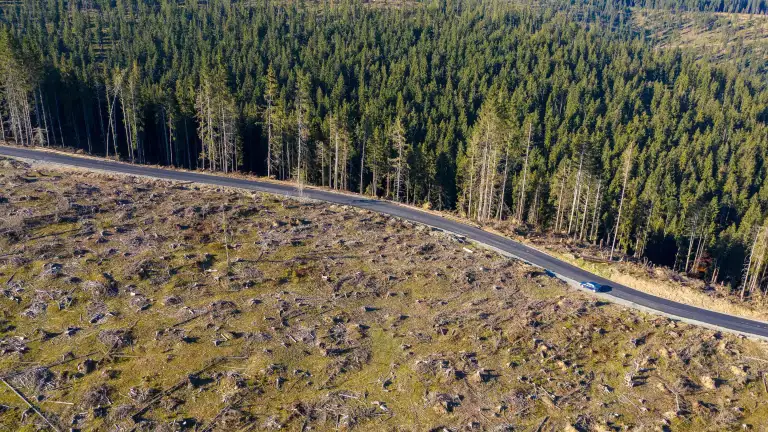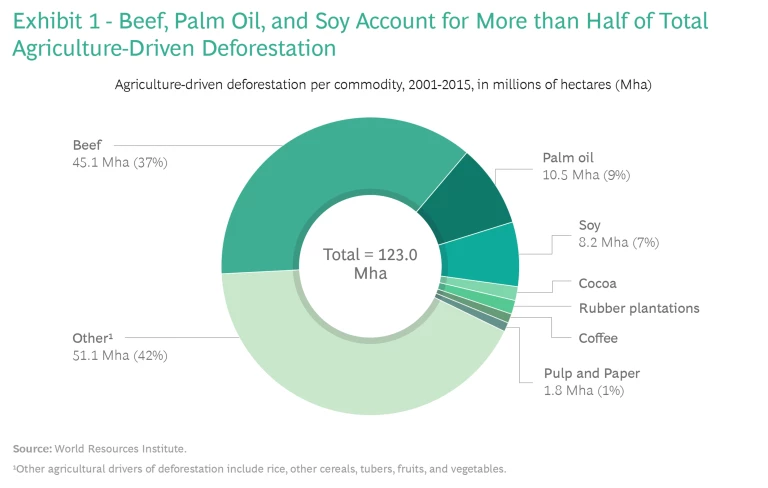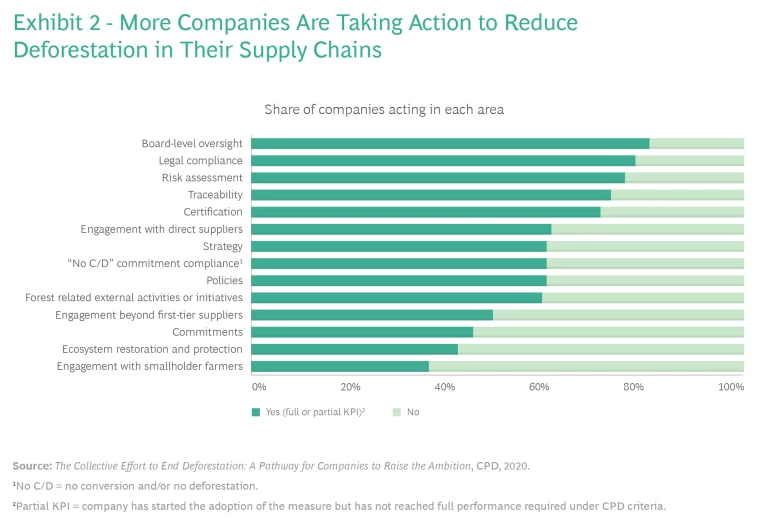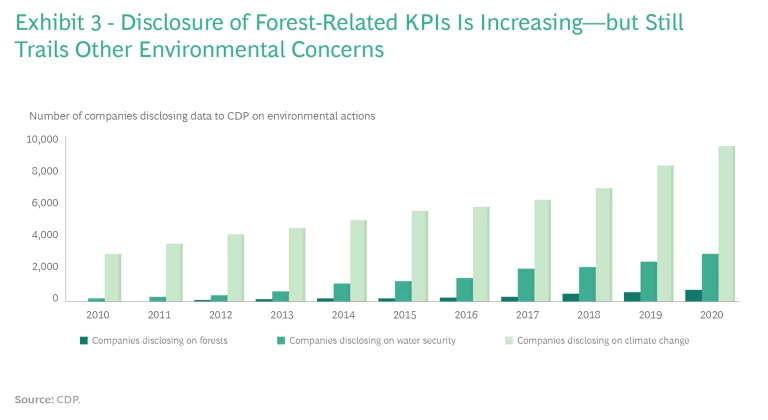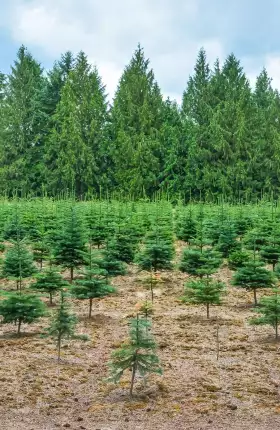Companies are accelerating efforts to ensure their products do not contribute to global forest loss. But individual company action, while necessary, is not enough.
Forests, grasslands, and savannas are being destroyed and degraded at a rapid clip, with dire consequences for climate, nature—including many of the most critical ecosystems—and humanity. Consumer companies, grocery retailers, commodity traders, and other players in the food and beverage supply chain have an important part to play in arresting that destruction. And indeed, many have been moving to eliminate deforestation from their value chains for more than a decade. Yet the impact of these efforts has not matched the growing urgency of the challenge.
There are a number of reasons for the frustrating pace of progress, but a major one is that most of the action by companies to date has focused on their own supply chains. While that’s an important step, action at the individual company level is not sufficient. Deforestation is a systemic problem, and it requires a systemic response—one that engages all stakeholders across the value chain and within key production landscapes to find ways to ensure that trees are worth more standing than cut down.
Momentum for systemic action is building, most notably the announcement at the UN Climate Change Conference (UNFCCC COP26) that 114 countries—representing 87% of forests—committed to reverse forest loss and land degradation by 2030. And in the consumer industry a number of companies have already stepped up to drive more collective action. The efforts of coalitions such as the Consumer Goods Forum’s Forest Positive Coalition of Action, the Lowering Emissions by Accelerating Forest finance (LEAF) Coalition, and the One Planet Business for Biodiversity (OP2B) coalition reflect that while putting a stop to deforestation is a societal imperative, it can also yield significant business benefits, including enhanced customer loyalty and operational resilience.
As more companies join these groups, they should embrace four principles to unlock the impact of collective efforts:
- Act, learn, and adapt. Companies should take the lead in addressing deforestation in key commodities and landscapes, be willing to adapt their approaches based on lessons learned, and encourage others to join the effort.
- Raise the standards on certification and embrace transparency. Companies should help advance consensus on certification standards, support suppliers as they strive to meet those standards, and disclose progress.
- Aspire to a highly ambitious system-level response. Companies must ensure their efforts also incorporate the economic needs of local populations—and they must accept the unavoidable complexity of collective action.
- Educate and encourage awareness among consumers. Companies should explain their efforts to fight deforestation to their consumers, encourage higher standards of choice, and build consumer awareness.
Ultimately, the drive to eliminate deforestation will require more than incremental changes to the way business has historically been done. A profound transformation of supply chains for key commodities is needed. As a result, the success or failure of collective efforts will depend on the commitment and resilience of the corporate leaders who will be driving that business model. Consumer company CEOs must put deforestation at the center of the C-suite agenda, not just delegate it to the operations or the sustainability teams within their organizations. In doing so, they can be catalysts for progress—demanding results and accelerating alignment and coordinated action within their own organizations while influencing others within the industry (and beyond) to step up and support collective action.
Why Consumer Companies Need to Act Now
Deforestation, including the conversion of land for agriculture and the degradation of forested areas, is increasing at an alarming rate. In 2001, an estimated 6.6 million hectares of forest disappeared; in 2020, the loss was 14.7 million hectares, according to Global Forest Watch. That’s the equivalent of roughly 40 soccer fields disappearing every minute.
The accelerating loss comes with a steep price. For one thing, forests are a massive carbon sink, capturing and storing 7.6 billion net metric tons of CO2, the equivalent of 1.5 times the total annual CO2 emissions in the US. And grasslands and savannas store another 150 to 250 tons of carbons per hectare. As those ecosystems are destroyed, carbon is released: according to the Environmental Defense Fund, roughly 20% of current greenhouse gas emissions come from deforestation.
In addition, deforestation is a major driver of biodiversity loss. Forests are home to 80% of the world’s known terrestrial species, with vital tropical forests in particular being highly threatened. As those forests are lost, biodiversity declines. Biodiversity is critical to the functioning of the planet through the provision of “ecosystem services” such as climate regulation, air purification, and water filtration—services estimated to be worth roughly twice the global annual GDP. The loss of those services creates massive sanitary risks for humans, threatening the livelihood of billions of people and degrading the overall ability of the planet to support human life.
The Role of Consumer Companies. Agricultural and forestry activities are a key driver of deforestation. As the primary user of agricultural inputs globally, the food sector has a vital part to play in arresting that loss. Between 2001-2015, forestry and agriculture activities accounted for roughly 39% of total deforestation, according to the World Resources
Four major commodities that are important components in the food supply chain—beef, palm oil, soy, and pulp and paper—account for roughly 54% of agricultural deforestation. Beef is the single largest driver, responsible for 37% of total agricultural deforestation—including the conversion of land for the creation of pastures as well as for the production of animal
The Imperative for Action. Consumer companies are increasingly focused on addressing their impact on deforestation. Their action is spurred by three factors.
First, eliminating deforestation from the supply chain aligns with the purpose and sustainability agenda at many companies. By ensuring a deforestation-free supply chain, companies can also advance other critical sustainability initiatives. Forest protection and restoration, for example, is a key lever to meeting the Paris Agreement goals: nature-based solutions are expected to represent up to 35% of economically viable climate-mitigation measures needed between now and 2030. Those solutions—including putting a stop to forest conversion, supporting reforestation, and adopting sustainable forest management—are projected to be among the most cost-effective levers for emissions reductions over that period. However, companies that do not move now to secure agreements for nature-based solutions (carbon credits backed by specific reforestation or afforestation projects, for example) will find those solutions are in short supply in the years ahead.
Second, the business case for action has grown more compelling. Stakeholders are increasingly demanding that companies in general, and food companies in particular, take the lead on addressing sustainability issues, with deforestation being a top priority. These stakeholders include:
- Consumers. Fires in the Amazon and Australia in 2019 and 2020 have elevated public awareness and concern about forest loss. And a recent BCG survey found that overall environmental awareness has grown: about 70% of people are more aware now than before the pandemic of the connection between consumption patterns and environmental degradation. In addition, 87% of respondents expect companies to contribute to solving environmental issues and 77% believe public subsidies should be conditioned on that.
- Government. There is increasing pressure for action on deforestation from public authorities. A number of governments, for example, endorsed two initiatives aimed at protecting global forests: the New York Declaration on Forests in 2014 and the Amsterdam Declarations in 2015, with more than 50 multinational companies also signing onto the former.
- Investors. Institutional investors are increasingly focused on ESG performance—and halting deforestation can be a key factor in the ability of companies to meet ESG goals and commitments. Such commitments are increasingly required in order for companies to raise funds in debt and equity markets at competitive rates and prices.
- Employees: Workers care more than ever about the purpose and sustainability of the organizations they work for. According to a 2020 survey of more than 200,000 people in 190 countries by BCG and the Network, a global alliance of more than 60 leading recruitment websites, nearly 70% of respondents reported that the issue of environmental responsibility had become more important to them over the last year—and more than 50% said they would not work for an employer whose environmental responsibility did not match their own.
As stakeholder pressures mount, particularly from consumers, companies that move quickly to become forest positive—meaning they have removed deforestation from their production footprints—will strengthen their overall resilience. That’s because they have reduced their reliance on sensitive commodities (those that drive deforestation in important ecosystems) while ensuring sufficient access to sustainably sourced commodities such as soy and palm oil—inputs that may be in short supply in the years ahead.
Finally, consumer companies have the leverage to coordinate and drive change. While their suppliers are often smaller players operating amid a large number of competitors, food, consumer packaged goods companies, and food retailers are typically large companies operating in a relatively unfragmented stage of the value chain. Not only do these larger companies have greater resources; they also have greater influence, and they can more easily bring other actors from the sector to the table to set and commit to improved practices and standards.
The Need for Collective Action
Certainly, a number of companies are taking ambitious action to build a forest-positive supply chain. And all companies should redouble such efforts. But as deforestation continues unabated, it is clear that individual action by even the most committed companies isn’t enough.
Company Efforts to Combat Deforestation. There are 14 actions designed to reduce deforestation in company supply chains. According to a March 2021 report by the Carbon Disclosure Project (CDP), 93% of companies (consumer and otherwise) are taking at least one action against
However, roughly 85% of companies are still at an early or developing stage for action, meaning they have incorporated less than 8 actions against deforestation. The most common actions adopted to date include board-level oversight, legal and compliance measures, risk assessments, and the use of certification and traceability for the products the companies procure. (See Exhibit 2.)
Fewer companies have taken actions such as engaging across their whole supply chains—including with smallholders and suppliers beyond the first tier—and restoring and protecting ecosystems. Not surprisingly, these are areas where individual company action is likely to have less impact and where collective efforts therefore make the most sense. In addition, company actions frequently fail to cover all of the commodities they purchase, some of which contribute significantly to deforestation. So, while 71% and 66% of companies have made commitments on palm oil and pulp and paper, respectively, just 31% have made commitments on soy and 28% on beef. That’s problematic, given that soy and beef combined account for approximately 44% of commodity-driven
The Power of Coalitions. Even if the pace of activity at the company level picks up dramatically, it won’t be enough to halt deforestation. However, coalitions can be powerful catalysts to build on and amplify individual company action. They can bring more companies to the table, expanding deforestation commitments across the industry’s production footprint and driving change throughout the supply chain. Furthermore, coalitions, by working also in close cooperation with local authorities and public institutions, non-governmental organizations (NGOs), and other partners, can address more difficult systemic problems such as those associated with illegal activities or poor forest governance.
As companies consider how to best drive collective action, they should give particular attention to the power of coalitions, a form of collaboration that has increased significantly in recent years. Among the advantages of coalitions:
- They allow members to start acting and pushing actions without having to wait for global consensus or alignment within their industry.
- They level the playing field by progressively defining common commitments and standards. Absent such industry alignment, companies that push for deforestation-free inputs from suppliers can end up with higher costs than competitors who do not demand similar sustainable inputs. In fact, action by individual companies can actually shift demand to areas without deforestation commitments (known as “leakage”). Today, roughly 80% of companies without a commitment against deforestation are from Latin America or Asia, according to Forest500, a project of the nonprofit Global Canopy that works to address the market forces destroying tropical forests. Actions against deforestation by companies in Europe, for instance, could therefore push production to Latin America and Asia.
- Instead of companies only working individually to adjust their footprints for a single commodity, coalitions allow companies and other stakeholders to take a landscape approach—one that drives collective, holistic action covering the use of resources by all key stakeholders in a given production area—or a jurisdiction approach, one focused on a specific region or country. (See the sidebar, “Protecting the Siak-Pelalawan Landscape.”)
- Coalitions can also help companies accelerate their individual efforts, including by assisting in the setting of coalition-wide targets, the development of collaborative roadmaps to reach those targets, the creation of transparent reporting from members, and the sharing of key lessons and best practices. And as coalitions gain in membership, there is likely to be a tipping point at which a forest-positive business model goes mainstream in the mind of consumers—prompting even those companies that are late to the party to embrace the approach.
Protecting the Siak-Pelalawan Landscape
To understand how a landscape approach works, consider the Siak-Pelalawan Landscape Programme (SPLP). SPLP is a private-sector-driven initiative launched by the SPLP Coalition, an organization formed by companies that source and use palm oil from the Siak and Pelalawan districts of Riau province, Indonesia. The program involves collaboration among the local government, palm oil suppliers, local communities, and NGOs and aims to ensure that palm production in those districts is deforestation-free and contributes positively to local communities. The initiative aims to hit several goals by 2025:
- Palm oil produced in and sourced from Siak and Pelalawan districts does not contribute to deforestation or the destruction of peatland.
- In at least 50 high priority villages in Siak and Pelalawan, the livelihoods of palm oil farmers and their communities are improved.
- Palm oil in Siak and Pelalawan is produced with respect for the human rights of workers and communities.
- Functioning multistakeholder partnership platforms are in place that include the local government and provide clear governance and transparent reporting on sustainable practices.
Ultimately the effort aims to build mechanisms for local communities to thrive through sustainable palm oil production, finding synergies between environmental and economic objectives.
In addition to COP26, a number of important events this year, including the UN Food Systems Summit and the UN Biodiversity Conference (UNCBD COP 15), will intensify the focus on advancing action to fight deforestation. At the same time, consumer companies are redoubling their efforts toward collaboration. In 2020, the Consumer Goods Forum launched the Forest Positive Coalition of Action, which now has 20 international consumer and retail company members. These companies have not only taken steps to address their own impact on deforestation but are also moving to collectively address the impact from the production of key commodities including beef, palm oil, soy, and pulp and paper. Similar forms of collective action through coalitions are also gaining traction—including organizations such as LEAF, which aims to mobilize at least $1 billion in financing to protect tropical forests, and OP2B, which is catalyzing action to address the agriculture-driven decline in global biodiversity.
Maximizing Impact
Nevertheless, gaining traction against deforestation—at the individual company level or through coalitions—is not easy. Companies that want to move the needle on deforestation must start by ensuring strong endorsement and leadership at the top. CEOs must drive the effort in a way that reinforces their companies’ sustainability purpose and values, focusing relentlessly on the issue of deforestation and ensuring that the commitment to a forest-positive business is integrated into all company functions. To do this they typically address three levels of action:
- Level 1: Individual supply commitments. At the first level, companies focus on ensuring their supply chains are deforestation free. Overall, companies must ensure their individual actions related to building a forest-positive business are exemplary. This starts with making the fight against deforestation a top C-Suite strategic priority and making bold individual commitments on all deforestation-risk commodities.
- Level 2: Supplier engagement and commitments. At this level, companies move beyond a focus on their specific production footprints. They influence and incentivize their own suppliers to halt conversion of natural habitats for agricultural and other uses, and they push those suppliers to address other issues, such as human-rights risks, across their entire operations.
- Level 3: Ecosystem engagement and commitments. The aim here is to change the system, leveling the playing field at the sector or industry level or between geographies, by harmonizing standards and requirements.
Companies have direct control over the actions at levels 1 and 2. Coalitions, meanwhile, can serve as catalysts for progress at level 3—the ecosystem level. This requires a coordinated effort by businesses, one that rallies support from governments—national, regional, and local—as well as the finance sector and NGOs working at the source, especially in the most sensitive production landscapes.
To maximize the impact of a coalition, companies should take four steps.
Act, learn, and adapt. The threat from deforestation is too dire for companies to delay. Certainly, the commitments at COP26 to halt deforestation by 2030 are encouraging. However, what happens in the interim—and the degree to which forests are preserved or lost over that time period—will be as important as hitting that 2030 goal. With the UN calling for a “decade on ecosystem restoration,” companies in the food sector have a unique opportunity to take a leadership role in ending deforestation.
Those who have not yet joined a coalition should do so. And those who have should demonstrate leadership by not only accelerating their individual and collective commitments but also by rallying others. Companies should, for example, relentlessly encourage others in their ecosystems to join the fight against deforestation and share best practices.
At the same time, they should work with local and national governments, NGOs, local community groups, and regulatory authorities to scale up impact in production landscapes or jurisdictions. For their part, government and regulatory authorities should help companies by providing adequate legal and regulatory frameworks as well as guidance on the prioritization of initiatives and their implementation.
Raise the standards on certification and embrace transparency. Certifications, including those related to deforestation, are a good lever for improvement. However, they come with some significant limitations. For example, certifications often have differing standards and definitions; there can be significant variation in strictness among standards, and many certifications do not enforce traceability and transparency in the supply chain. Companies and key stakeholders should work together to address issues related to certification standards, including agreeing on common definitions and measurements of deforestation. And they should help suppliers understand the new standards and offer support to suppliers as they transform their businesses to meet them.
Coalition members should also work together to create transparency and define KPIs in line with their commitments, and report both on individual and shared KPIs. When it comes to individual-company level commitments, companies should set clear and rigorous targets, with concrete milestones and KPIs, and specify their implementation mechanisms. And they should be transparent on their progress—or lack of progress. According to the CDP, only about 66% of companies with a deforestation commitment had reported on their progress toward their deforestation commitments in the last two years. There is certainly room for improvement, especially considering companies’ relative progress in reporting on other areas such as climate change or water security. (See Exhibit 3.)
Aspire to a system-level response. Coalition members need to keep in mind that converting forests for agriculture has been a growth driver and a way to foster economic returns for rural communities in Latin America and Asia, and even in Europe and America, for decades if not centuries.
Consequently, actions that only target conservation and sustainable management of forests and restoration or rehabilitation of deforested areas are not enough to create a forest-positive future.
Coalition members also need to build well-rounded economic systems that will incentivize local populations to embrace the forest-positive vision. This means supporting their rights and helping them improve production yields—and their livelihoods—through regenerative farming practices. Companies need to work together with local communities to identify credible and attractive economic opportunities that offer a win-win alternative to deforestation.
Developing the right approach is a complex undertaking. Companies need to step out of their comfort zones and accept the complexity that comes with advancing system-level change.
Educate consumers and encourage awareness. Increasing consumer demands for sustainable products should not be perceived as a risk but rather as an opportunity to enhance a company’s brand image, create positive differentiation, and (in some cases) develop and launch premium products.
Companies can work within their coalitions to educate consumers about the threat posed by deforestation as well as the most promising solutions. That will help consumers understand and better value actions by companies that are leading the effort against deforestation. Companies should encourage consumers to be adamant about avoiding products and brands that drive deforestation and to be willing to pay a premium for products that are deforestation free. And companies and coalitions should share lessons along the way—in particular, those related to how to drive change at the production-landscape level.
Deforestation poses a significant threat to climate, the planet, and humanity. For companies in the food sector, reshaping their businesses and supply chains to be forest positive is not only a business imperative—one that will help them secure a sustainable supply of critical raw materials—it’s also an opportunity to strengthen ties with their consumers and other critical stakeholders.
To seize that opportunity, companies cannot simply go it alone. Food sector companies must find ways to drive change across the larger system in which they operate. A critical lever for doing that is the establishment of coalitions. Coalitions can scale and accelerate efforts to stop deforestation at both the sector and landscape level. Companies across the entire food production sector—consumer companies, retailers, and other participants—should leverage that potential to address a critical planetary challenge.
